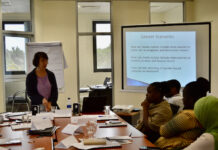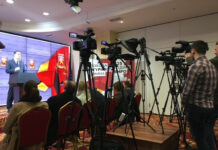
Important grammatical rules for news writing
In this, the third module in the series about language and style from The News Manual, we look at some of the most important grammatical rules for news writing, at some common mistakes and how to correct them.
In the previous two modules we discussed the basics of structuring your stories well and using the correct words. The third element of good writing is grammar – the rules by which the words fit into the structure.
With so many people using a language as complex as English, there are lots of opportunities for making errors. We cannot possibly list them all here. We will, however, remark on some of the most common mistakes made by journalists.
Collective nouns
Some nouns which are collections of individual parts are treated as plural, while others are treated as singular. It is very much a matter of which style your particular newspaper or broadcasting station uses, but there is a general guideline. If individuals within the group act or make decisions as a single body, use the singular verb.
RIGHT: The Government said it was going to abolish income tax.
WRONG: The Government said they were going to abolish income tax.
However, if the collective group is more noted for its individual parts, treat it as a plural. This is commonly done for sporting teams.
RIGHT: The team manager said they were going to win.
WRONG: The team manager said it was going to win.
A singular noun should be treated as singular even when it contains several things. For example, we say that:
A bag of coconuts is sitting on the table.
A flock of sheep is grazing in the field.
The bus full of nurses is waiting outside.
This is because the subject of the sentence is “a bag”, not “coconuts”; “a flock”, not “sheep”; and “a bus”, not “nurses”.
Neither, none, each and every
The words neither, none, each and every are treated as singular when they are the subject of a verb, even though they refer to more than one thing or person. This is because the words mean not either one, not one, each one and every one.
RIGHT: Neither the man nor the woman is able to speak.
WRONG: Neither the man nor the woman are able to speak.
The word none is treated as singular (because it is short for not one), even though it is usually followed by a plural noun. The subject of the sentence is none (i.e. not one) and therefore needs a singular verb. The subject of the sentence which follows is not men, it is none:
RIGHT: None of the men was willing to testify in court.
WRONG: None of the men were willing to testify in court.
The words each and every are treated as singular, even though they may be followed by a long list of things they refer to.
RIGHT: Every car, bus, bicycle and rickshaw in the city has to be licensed.
WRONG: Every car, bus, bicycle and rickshaw in the city have to be licensed.
Misplaced modifiers
When you use a phrase to modify or describe part of a sentence, make sure that it describes the correct part. The rule is that the modifier attaches to the noun nearest to it. Mistakes can sometimes be very amusing. In this example, the modifier is in italics.
RIGHT: The plane came to a halt in front of the clan chief who was dressed in a grass skirt.
WRONG: Dressed in a grass skirt, the plane came to a halt in front of the clan chief.
I, me, we and us
These become a problem when you turn someone’s quotes into reported speech. It is correct to use I, me, my, we, us, and our within quotation marks, but once you take the quote marks away and write in reported speech, you have to make the following changes:
I becomes he or she,
me becomes him or her,
my becomes his or her.
We becomes they,
us becomes them,
our becomes their.
you becomes him, her or them,
your becomes his, hers or their.
Many journalists remember to change the I, me and my in reported speech but forget about the rest of the changes that have to be made. In the following example, we show the right and wrong ways of turning a sentence from quotes into reported speech. The original sentence in quotes was:
The Prime Minister of Fiji told soldiers in Suva: “I will do my best to protect our country.”
Turned into reported speech, it becomes:
RIGHT: The Prime Minister of Fiji told soldiers in Suva that he would do his best to protect their country.
WRONG: The Prime Minister of Fiji told soldiers in Suva that he would do his best to protect our country.
In the wrong version above, leaving the word “our” in the sentence implies that we, the journalist, are included in the story.
It is sometimes not enough just to change a few words. Sometimes you will have to add words of explanation. In the correct sentences above, it is clear who is speaking to whom. However, when changing quotes into reported speech it occasionally becomes less clear, especially in paragraphs later in the story. Suppose the Prime Minister then went on to tell the soldiers:
“I can do so much, but I also need your help.”
In reported speech you would then have to write:
The Prime Minister of Fiji told soldiers in Suva that he would do his best to protect their country. He said he could do so much, but he also needed help from the army.
This would be an acceptable solution in writing for radio and television, where you should not use direct quotes in scripts. If you are writing for the print media, the best solution is to give the quotes themselves.
Its and it’s
There is often confusion over these two words. The rule is simple. Use its when referring to something belonging to it. Use it’s as a short form for it is. For example:
The wounded animal returned to its lair.
The hunter said: “It’s not clear what is happening at the moment.”
Punctuation
Here are some basic rules of punctuation used in most style books. The Golden Rule of all writing, however, is to keep it simple and clear.
Capital letters
These are used at the beginning of sentences and for the names of people and places. Capitals are also used at the beginning of words which are a titles rather than a description. For example, we write about “the Government of Sri Lanka” because that is the title of one specific body, but we write of “agreements between governments” because we are speaking about governments in general. The following example demonstrates the difference:
Eight prime ministers attended the meeting, hosted by the Prime Minister of India.
Capital letters should also be used for the trade names of products and companies. For example:
The Universal Cement Company produces cement called Cemebond.
Full stops
Called “periods” in America, full stops are used at the ends of sentences, as decimal points and with certain standard abbreviated place names. For example, in America Cal. for California or N.Y. for New York; in Australia W.A. for Western Australia or Vic. for Victoria., though it becoming increasingly common to drop the full stops in informal use. However, unless the abbreviation is one well-known to your audience, write the name in full. Journalists working for radio or television normally give the names in full.
When used at the end of a quote, the full stop comes within the closing quotation mark:
He said: “This is not what we wanted.”
Not all abbreviations use full stops. Most newspapers today do not use them to abbreviate Mr, Mrs, Ms, Dr, Rev and similar common titles.
It used to be the case that full stops were used within abbreviations of titles. Increasingly, editors are choosing to leave them out, as in USA, PNG or UN.
Commas
The comma in written English acts very much like a pause in the spoken language. It is used within sentences to separate phrases or lists of words, as in the following example:
The company, which was only set up last year, now produces a range of goods including tyres, steering wheels, exhaust systems and windscreens.
Notice that there is no comma before the and at the end of the list.
Commas should only be inserted to help reading or listening. If you find you have several commas in your sentence, it is probably too long and should be split into separate sentences.
Semi-colons (;)
Their main use is to separate phrases which already contain commas, especially in lists:
The winners were: Bagu Lagi, geology; Jim Ho, physics; Peter Graham, Doro Meeni and Fa’afo Tokala, economics; and Nga Nganda, history.
Colons (:)
There are two principle uses for the colon in news-writing. One is at the start of lists, as in the example above. The second is when going from attribution into a quote:
The judge said: “This is not the first time I have had to deal with this kind of case.”
Apostrophes (‘)
There are several uses for apostrophes. The most common is to show possession. It is usually used in front of an s. In this example, the printery belongs to the company:
Fire last night destroyed the company’s main printery.
However, when a plural noun ends with an s, the apostrophe is not normally followed by another s:
Frank’s jokes were a great success at his parents’ anniversary party.
In the sentence above, the jokes belonged to Frank, so we add an ‘s. However, the word parents already ends in s, so we just add an apostrophe. Apostrophes are also used in contractions in place of missing letters or numbers:
“In the ‘34 gold rush, miners couldn’t get to Bulolo quickly enough,” he said.
Quotation marks (“ “)
These should mainly be used to distinguish spoken words, although some journalists use them when quoting from written reports.
Hyphens (-) and dashes ( – )
Hyphens are used to pull words together, and dashes are used to separate phrases, usually for dramatic effect.
Hyphens are used to join two or more words into one idea, for example: non-agreement, well-meant, Vice-Chancellor, mother-in-law. They are also used in some words to avoid ambiguous meaning. For example, the hyphen distinguishes between re-cover (to cover again) and recover (to get something back).
The dash (which is given more space than a hyphen) is used to indicate a dramatic shift or a surprise phrase, as in the following example intro.
David Paro arrived home from work yesterday to find an unwelcome gift on his verandah – three tonnes of manure.
Do not use the dash unless it is necessary; it can get tiresome to readers.
Question marks (?)
These should only be used after a direct question, which means they usually appear within quotation marks. Examine the following combinations to see the right and wrong uses of question marks:
RIGHT: The doctor asked Mary: “When did you last give blood?”
RIGHT: The doctor asked Mary when she had last given blood.
WRONG: The doctor asked Mary: “When did you last give blood.”
WRONG: The doctor asked Mary when she had last given blood?
Journalists sometimes wrongly ask their readers questions, particularly in writing features. The journalist’s job is to answer readers’ questions, not leave them guessing, so avoid posing questions.
Exclamation marks (!)
You should not need these in news-writing. In novels they are inserted to signify drama. If you are a good reporter your story should do that for you. You should only use them at the end of a quote which is an exclamation or an order, for example:
Mr Paro took one look at his veranda and said: “Damn!”
Ellipsis (…)
This is a series of three dots put into quotations to show that something has been missed out:
“The car struck several objects … before coming to rest against a tree.”
You should try to avoid this if at all possible, as it suggests to your reader that you are hiding something.
The ellipsis is frequently used instead of a dash in radio and television news-writing. The newsreader knows to allow an expectant pause before finishing the sentence. So in radio, we might rewrite the manure example:
David Paro arrived home yesterday to find an unwelcome gift on his veranda … three tonnes of manure.
Brackets ()
You should also avoid brackets in news-writing. They are meant to contain extra detail within a sentence, but are more often used by lazy journalists to avoid having to rewrite sentences correctly. Some newspapers allow their use when explaining abbreviations, for example:
A surgeon suffering from Acquired Immune Deficiency Syndrome (AIDS) has been sacked from his job in the country’s main hospital.
To summarise
- Keep your language clear and simple so that your readers or listeners can understand.
Sentence structure should be simple. - Check all your work to make sure that everything you write obeys the rules of grammar and punctuation.
This module is taken from The News Manual’s Chapter 12: Language & Style – Grammar.
Related training modules








